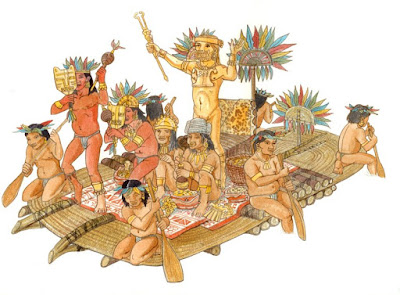Chichas
Constructions
of the houses
The
pre-Columbian architecture that reached between the Aztecs, the Maya and the
Peruvians his more brilliant and admired artistic expressions, not pipe between
the chibchas at least a purchasable development with that of those cultures.
The essential difference consists of the employment of the stone for the
constructions.
· Musical
Instruments
In the battles and in the holidays were using
the chibchas instruments of music, some as species of oversweet, done of sewed
clay.
Politico - Social
Upon arrival of the Spanish in the Muisca territory there were 5 independent federations, consisting of 25 tribes:
• The Confederation of Bacatá or Bogota: It was the longest, she belonged to some 20 tribes which ruled the zipa, included a large part of the department of Cundinamarca.
• The Confederation of Hunza or Tunja: covers some cold climates north of Cundinamarca and Boyacá much. The Zaque the ruled.
• The Confederation of Tundama or Duitama, composed of few tribes
• The Confederation of Sogamoso or Iraca: low land area. There lay the priest most importantly, dedicated to the worship of the sun.
• The Confederation of Indian Guanes: formed by a subset of the Muisca occupied pots and Chicamocha Suarez rivers and the table of Lerida in Santander.
Upon arrival of the Spanish in the Muisca territory there were 5 independent federations, consisting of 25 tribes:
• The Confederation of Bacatá or Bogota: It was the longest, she belonged to some 20 tribes which ruled the zipa, included a large part of the department of Cundinamarca.
• The Confederation of Hunza or Tunja: covers some cold climates north of Cundinamarca and Boyacá much. The Zaque the ruled.
• The Confederation of Tundama or Duitama, composed of few tribes
• The Confederation of Sogamoso or Iraca: low land area. There lay the priest most importantly, dedicated to the worship of the sun.
• The Confederation of Indian Guanes: formed by a subset of the Muisca occupied pots and Chicamocha Suarez rivers and the table of Lerida in Santander.
Religion and Ceremony
It was polytheistic. Their deities represented various forces of nature. Their main gods were Chiminichagua, supreme creative principle or force, Xue, sun, Chia, the moon, Bachue, the mother of humanity and goddess of the pulses, Cuchaviva the rainbow, Chibchacun, god general, Chaquen, god of the brokers and Bochica, civilizing hero.
It was polytheistic. Their deities represented various forces of nature. Their main gods were Chiminichagua, supreme creative principle or force, Xue, sun, Chia, the moon, Bachue, the mother of humanity and goddess of the pulses, Cuchaviva the rainbow, Chibchacun, god general, Chaquen, god of the brokers and Bochica, civilizing hero.


cultur muiscas.:

cultura mayas:
